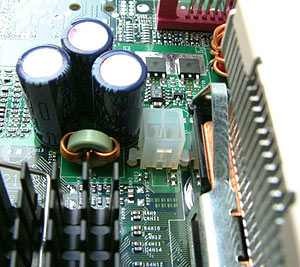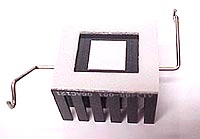Turning our
attention to the processor socket it is good to see that for the most part there
are no crowding issues. Occasionally, really large
capacitors find their way to the processor like a bunch of groupies around an aging rockstar.
In each case they limit access to the center of our attention, and in
the case of our good old processor, can make installing the chip or
heatsink rather awkward.
As far as we're concerned with the D850GB, this small grouping
of capacitors is out of the way. They do make it a bit of
a tight squeeze to plug in the 4-pin 12V VRM power lead, but
not overtly so.
 |
The
processor socket is in fairly open territory with no large processors crowding it in, or blocking
off the flow of air from the heatsink.
While the fit is a
tight one for the 4-pin power connector, we had no real
difficulties.
|
CPU Throttling
Unlike its AMD
counterparts, a Pentium 4 in trouble is adept enough to realize something is
wrong and decrease speed or shut down. These wondrous actions come thanks
to an internal diode which thermally monitors your expensive processor in the event of something
catastrophic like fan failure. If the processor exceeds its operating temperatures it will shut
down until the temperature has returned to a reasonable level.
After all the last thing you would
want to do is fry a 1.7 GHz processor in 4 seconds....
Tehama Heatsink
On the thermal side of things we
see that the Tehama chipset is covered by a new type of passive heatsink. Unlike
the BGA chipset coolers of old, the i850 heatsink is rather specialized. Namely,
the heatsink is attached to the FC-BGA chipset by means of two small spring
catches that hook into two little soldered in loops on the board. Where as the
BGA coolers we are most familiar with attach directly to the PCB by means of
small plastic pegs, or if it is a real quick job, by adhesive 'thermal' tape.
|

|
|
The Tehama chipset heatsink
clips onto the motherboard with small hooks and has some thermal
interface material on the base. |
It is easy to
see that a lot more care has gone into these specialized heatsinks
then the older green BGA heatsinks that were all too commonly used. The
Tehama heatsink even goes so far as to use thermal interface material and
a small ring of spongy material minimize the possibility of damaging the exposed silicon
core of the i850 chipset.
